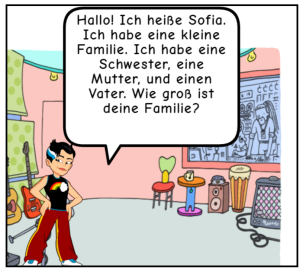2.2 Mehr über meine Familie

Hallo alle zusammen!
Let’s warm up with our Tagesminiplausch und Wiederholung.
Wiederholung
In the previous lesson, you learned how to say how big your family is, what members are in your nuclear family, and which are not. As a review, read and listen to Sofia’s introduction. Then, read Sofia’s introduction aloud and answer the question that follows.
 |
Listen to Sofia’s introduction. |
A friendly reminder that repetition is an important part of language learning. If you are having doubts about how to say something or the meaning of a word, your instructor is a great resource and would love to help.
Jetzt bist du dran!
Now write out how big your family is by copying Sofia’s words above and replacing the information with your own (Ich habe eine … Familie). Like Sofia, also say which people belong to your nuclear family. Then record yourself in your audio journal.
Lektionsüberblick
In this lesson, we will talk more in-depth about our families. In the end, you will be able to talk about some of your family members by 1) saying their names, 2) saying their ages, and 3) talking about your pets.
1) Saying family member names
Volker gives information about his family. Answer the questions next to the image (be sure to click through to each question).

Ich heiße Volker. Ich bin 26 Jahre alt. Ich komme aus Deutschland. Ich wohne in Berlin. Meine Mutter heißt Rita. Mein Vater heißt Holger. Ich habe einen Bruder. Er heißt Tim. Er ist 18 Jahre alt. |
|
Jetzt bist du dran!
München im Blickpunkt

BMW in München hat eine eigene Postleitzahl: 80788. Diese besondere Postleitzahl ist nur für die BMW Group und nicht für einen Stadtteil bestimmt. Im Werk München arbeiten rund 7 800 Mitarbeiterinnen und Mitarbeiter. Damit ist BMW einer der größten Arbeitgeber der Stadt und spielt eine wichtige Rolle für die Wirtschaft Münchens.
BMW in Munich has its own postal code: 80788. This special postal code is only for the BMW Group and not for a district. Around 7,800 employees work at the Munich plant. BMW is therefore one of the city’s largest employers and plays an important role in Munich’s economy.
2) Saying family member ages
Since we are talking about ages, let’s review the numbers, paying special attention to the numbers that represent the ages of your family members.
Now let’s read what the following people say about their brothers and sisters. Can you tell what words they use to talk about their siblings’ ages?
- In the last lesson, Adan talked about his family. He said this about his brothers: Ein Bruder ist 21, der andere ist elf.
- Above, Volker says this about his brother: Er heißt Tim. Er ist 18 Jahre alt.
- Do you remember Johannes? He says this about his siblings: Ich habe einen Bruder und zwei Schwestern. Mein Bruder ist 25 Jahre alt. Meine große Schwester ist 27 und meine kleine Schwester? Sie ist 13 Jahre alt.
Let’s practice!
Jetzt bist du dran!
-> Wie alt ist deine Mutter? Wie alt ist dein Vater? Wie alt sind deine Geschwister?
3) Meine Haustiere (My pets)
Pets are important members of many families, and we don’t want to overlook their importance here. So, let’s talk Haustiere!
Look at the conversation below, and then answer the question.

Have other types of pets? See if you can match these pets in the following activity using what you already know. (If you click on the information icon, you can read how the animals describe themselves.)
Kleiner Hinweis
What if you don’t have a pet?
-> In Lektion 2.1, you learned how to say that you do not have certain family members (e.g. Ich habe keine Brüder. Ich habe keine Schwestern.)
-> You use that negating word “keine” in this context, too –> Ich habe keine Haustiere.
Based on what you have learned so far, can you guess what these two sentences mean?
Meine Katze heißt Keks.
Mein Hund heißt Waldi.
(You can visit Deutsche Welle’s page on popular German pet names to learn more.)
Jetzt bist du dran!
Want to challenge yourself? Write the answer to this question in your journal: Wie heißt dein Haustier? / Wie heißen deine Haustiere?
Then record yourself in your audio journal.
Zum Schluß
*As you conclude this lesson, don’t forget to check Canvas!*

Media Attribution
- Haustier image, Public Domain
Media Attributions
- 1010-1020 banner long large reduced
- Sofia comic made at www.MakeBeliefsComix.com
- Photo of man in denim jacket by pexels-steshkawillems-2344601 © Steshka Willems is licensed under a CC0 (Creative Commons Zero) license
- Photo of BMW Headquarters by Nicola Raviglione: https://www.pexels.com/photo/bmw-headquarters-in-munich-19660026/
- Haustiere comic made at www.MakeBeliefsComix.com © This comic strip was generated at http://www.MakeBeliefsComix.com. Used by permission of author and site creator Bill Zimmerman.
- Private: confidence scale_large horizontal_updated


